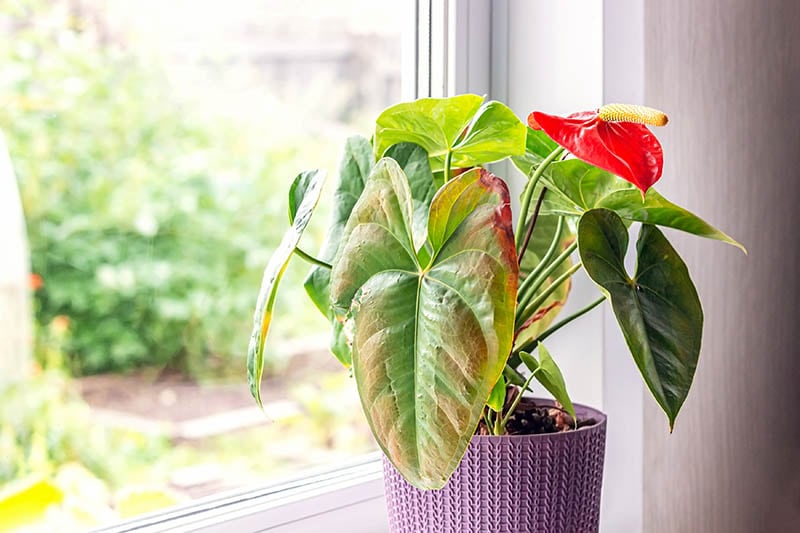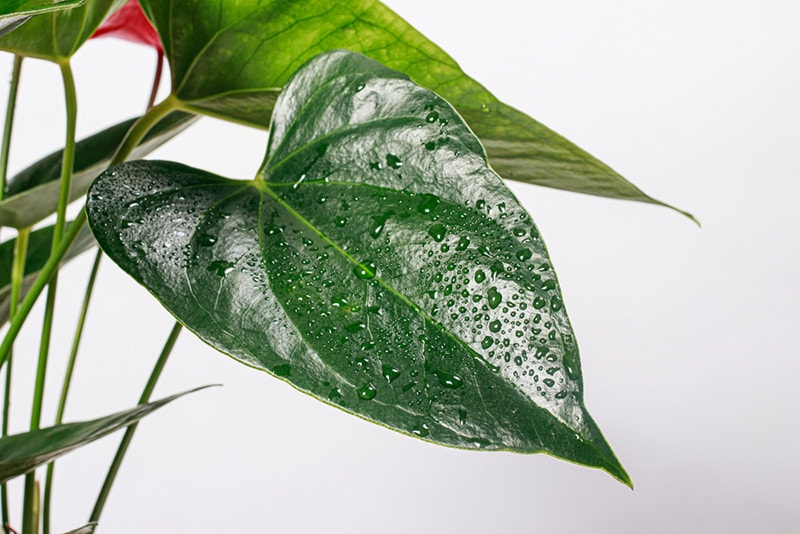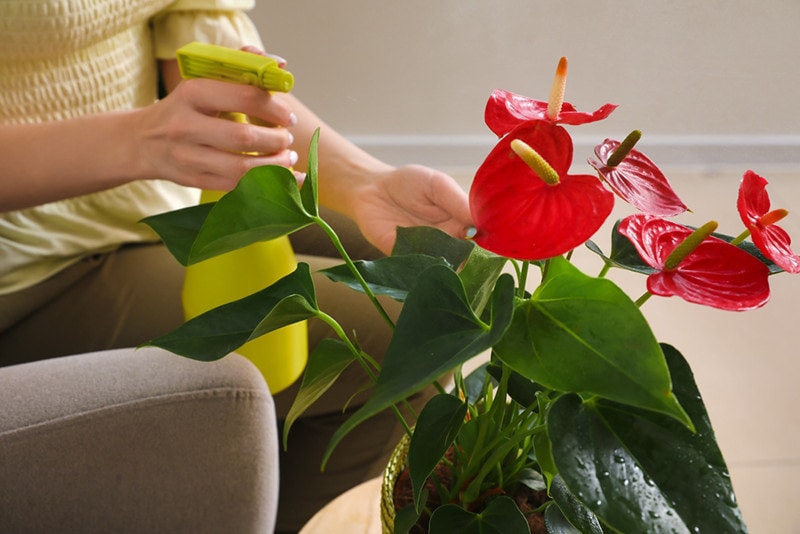How Much and How Often to Water Anthurium — 3 Simple Steps
-
Kristin Hitchcock
- Last updated:

Anthuriums are tropical plants, so many gardeners assume that they require lots of water. However, this isn’t actually the case. These plants are used to high humidity, but they don’t require tons of water. Usually, these plants only need to be watered every week or two, but there are exceptions to this rule.
How often you’ll need to water the plant will vary. In hotter climates, these plants need to be watered more often. In cooler climates (and in the winter), you’ll only need to water them every 2 weeks or so.
These plants are quite resilient, which is why they are often chosen by first-time gardeners. However, they are somewhat sensitive to the amount of water they need. If you’re not watering them properly, they will let you know.
The 3 Steps on How Much and How Often to Water Anthurium
1. Determining Water Requirements
While these plants don’t need tons of water, it’s hard to prescribe a hard and fast watering rule that works for all anthuriums. Your climate, the season, and the plant’s health will determine the amount of water it needs.
The easiest way to determine how much water your plant needs is to look at your plant. Even a very inexperienced gardener can determine if the soil requires watering with only a small amount of background knowledge.
Simply put, this is done by sticking your finger about 1–2 inches into the soil. If the soil is dry all the way to your fingertip, then the soil needs watered. Anthuriums like it when at least the top layer of soil dries completely between waterings, and this also helps reduce the fungus and insect count in the soil.
If the soil is wet within the first 2 inches of soil, then you should wait to water the plant.

Alternative Method
There is another way to determine water requirements. If you have a hard time determining if the soil is wet or not, this method is for you.
Pull out a small amount of soil from about one inch below the surface. Roll the soil between your fingers. If it can roll into a ball, the soil is still damp, and the plant doesn’t require water. If the soil is crumbly and won’t hold a ball shape, the plant needs water.
2. Watering Your Anthurium Correctly
Now that you’ve determined your plant needs water, you need to water the plant correctly. Luckily, this is rather simple and probably how you’re used to watering plants.
Anthuriums usually do just fine with “top watering.” Simply put, this involves pouring water onto the top of the soil. You’ll want to pour pretty evenly around the plant to ensure that all the soil gets some water—not just one spot.
Keep pouring until water comes out of the drainage holes on the bottom of the pot. Then, let the plant drain for about another 15 minutes. After that, the plant should be sufficiently drained, and you can move it back to its proper place.

Bottom Watering
You can also water your plant from the bottom. Many more sensitive plants require watering via this method. Anthurium doesn’t fall into this category. However, many gardeners still prefer this method when they have time.
You’ll want to fill a tray with about ½ to ¾ inches of water. Then, place the pot into the water. For this method to work, you absolutely need to have drainage holes in the bottom of the pot (though you will need those, anyway, to ensure your plant’s health).
The soil will soak up all of the water it needs through the drainage holes. The plant will need to sit for about 15–20 minutes before you remove the pot. The very top of the soil may never get wet. That’s okay. The important part is that the roots will get the water they need.
Bottom watering can also prevent overwatering, as the soil won’t soak up more than it needs.
3. What About Misting?
Because these plants are tropical, many new plant parents believe that they need misting. However, these plants don’t actually like constantly moist soil. If their soil is left wet too often, they may even up with root rot. Therefore, misting them regularly isn’t recommended—at least regularly. You want the soil to dry out completely whenever possible.
However, there is an exception to this rule. Anthuriums are used to living in high-humidity environments. Therefore, in many parts of the USA, these plants will need extra humidity. Many homes don’t have the humidity necessary for these plants to thrive, especially if you live in a drier area. If this includes you, then misting may be necessary.
In this case, we do recommend misting these plants every 2–3 days. However, you should focus the mist solely on the leaves and flowers of the plant. Do not get the soil soaked if you can help it. You just want the plant itself to get wet.
This misting will help the flowers last longer, as well. However, it can also help the leaves, so we don’t recommend just focusing on the flowers.

 Conclusion
Conclusion
Watering an anthurium isn’t complicated. Despite being tropical, these plants don’t like constantly moist soil. Therefore, you should allow the first couple of inches of soil to dry completely before you water the plant again. How long this is will depend on your climate. Drier areas may suck all the water from the soil in only 2–3 days. Other plants may need to be watered every 2 weeks.
Therefore, it’s much better to look at your plant when determining water requirements—not following a predetermined schedule.
Featured Image Credit: Okrasiuk, Shutterstock
Contents
